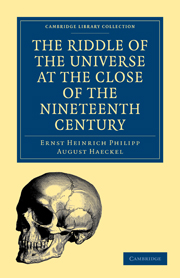Book contents
- Frontmatter
- Contents
- PREFACE
- AUTHOR'S PREFACE
- CHAPTER I THE NATURE OF THE PROBLEM
- CHAPTER II OUR BODILY FRAME
- CHAPTER III OUR LIFE
- CHAPTER IV OUR EMBRYONIC DEVELOPMENT
- CHAPTER V THE HISTORY OF OUR SPECIES
- CHAPTER VI THE NATURE OF THE SOUL
- CHAPTER VII PSYCHIC GRADATIONS
- CHAPTER VIII THE EMBRYOLOGY OF THE SOUL
- CHAPTER IX THE PHYLOGENY OF THE SOUL
- CHAPTER X CONSCIOUSNESS
- CHAPTER XI THE IMMORTALITY OF THE SOUL
- CHAPTER XII THE LAW OF SUBSTANCE
- CHAPTER XIII THE EVOLUTION OF THE WORLD
- CHAPTER XIV THE UNITY OF NATURE
- CHAPTER XV GOD AND THE WORLD
- CHAPTER XVI KNOWLEDGE AND BELIEF
- CHAPTER XVII SCIENCE AND CHRISTIANITY
- CHAPTER XVIII OUR MONISTIC RELIGION
- CHAPTER XIX OUR MONISTIC ETHICS
- CHAPTER XX SOLUTION OF THE WORLD-PROBLEMS
- INDEX
CHAPTER XVII - SCIENCE AND CHRISTIANITY
Published online by Cambridge University Press: 05 August 2011
- Frontmatter
- Contents
- PREFACE
- AUTHOR'S PREFACE
- CHAPTER I THE NATURE OF THE PROBLEM
- CHAPTER II OUR BODILY FRAME
- CHAPTER III OUR LIFE
- CHAPTER IV OUR EMBRYONIC DEVELOPMENT
- CHAPTER V THE HISTORY OF OUR SPECIES
- CHAPTER VI THE NATURE OF THE SOUL
- CHAPTER VII PSYCHIC GRADATIONS
- CHAPTER VIII THE EMBRYOLOGY OF THE SOUL
- CHAPTER IX THE PHYLOGENY OF THE SOUL
- CHAPTER X CONSCIOUSNESS
- CHAPTER XI THE IMMORTALITY OF THE SOUL
- CHAPTER XII THE LAW OF SUBSTANCE
- CHAPTER XIII THE EVOLUTION OF THE WORLD
- CHAPTER XIV THE UNITY OF NATURE
- CHAPTER XV GOD AND THE WORLD
- CHAPTER XVI KNOWLEDGE AND BELIEF
- CHAPTER XVII SCIENCE AND CHRISTIANITY
- CHAPTER XVIII OUR MONISTIC RELIGION
- CHAPTER XIX OUR MONISTIC ETHICS
- CHAPTER XX SOLUTION OF THE WORLD-PROBLEMS
- INDEX
Summary
Increasing opposition between modern science and Christian theology. The old and the new faith. Defence of rational science against the attacks of Christian superstition, especially against Catholicism. Four periods in the evolution of Christianity: I. Primitive Christianity (the first three centuries). The four canonical Gospels. The epistles of Paul. II. The papacy (ultramontane Christianity). Retrogression of civilization in the Middle Ages. Ultramontane falsification of history. The papacy and science. The papacy and Christianity. III. The Reformation. Luther and Calvin. The year of emancipation. IV. The pseudo-Christianity of the nineteenth century. The papal declaration of war against reason and science: (a) Infallibility, (b) The Encyclica, (c) The Immaculate Conception.
One of the most distinctive features of the expiring century is the increasing vehemence of the opposition between science and Christianity. That is both natural and inevitable. In the same proportion in which the victorious progress of modern science has surpassed all the scientific achievements of earlier ages has the untenability been proved of those mystic views which would subdue reason under the yoke of an alleged revelation; and the Christian religion belongs to that group. The more solidly modern astronomy, physics, and chemistry have established the sole dominion of inflexible natural laws in the universe at large, and modern botany, zoology, and anthropology have proved the validity of those laws in the entire kingdom of organic nature, so much the more strenuously has the Christian religion, in association with dualistic metaphysics, striven to deny the application of these natural laws in the province of the so-called “spiritual life”—that is, in one section of the physiology of the brain.
- Type
- Chapter
- Information
- Publisher: Cambridge University PressPrint publication year: 2009First published in: 1900

